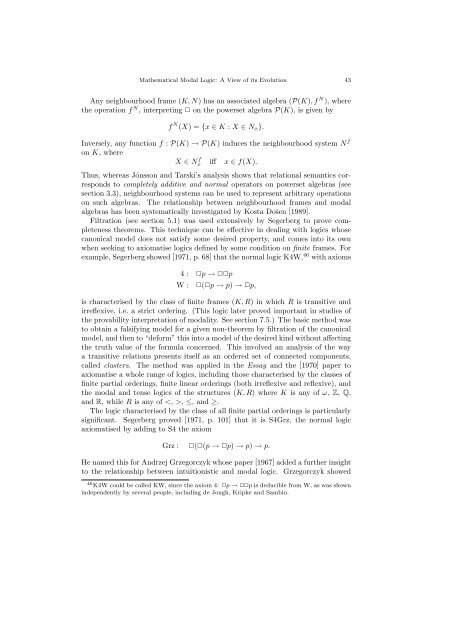MATHEMATICAL MODAL LOGIC: A VIEW OF ITS EVOLUTION
MATHEMATICAL MODAL LOGIC: A VIEW OF ITS EVOLUTION
MATHEMATICAL MODAL LOGIC: A VIEW OF ITS EVOLUTION
Create successful ePaper yourself
Turn your PDF publications into a flip-book with our unique Google optimized e-Paper software.
Mathematical Modal Logic: A View of its Evolution 43Any neighbourhood frame (K, N) has an associated algebra (P(K), f N ), wherethe operation f N , interpreting ✷ on the powerset algebra P(K), is given byf N (X) = {x ∈ K : X ∈ N x }.Inversely, any function f : P(K) → P(K) induces the neighbourhood system N fon K, whereX ∈ N f x iff x ∈ f(X).Thus, whereas Jónsson and Tarski’s analysis shows that relational semantics correspondsto completely additive and normal operators on powerset algebras (seesection 3.3), neighbourhood systems can be used to represent arbitrary operationson such algebras. The relationship between neighbourhood frames and modalalgebras has been systematically investigated by Kosta Došen [1989].Filtration (see section 5.1) was used extensively by Segerberg to prove completenesstheorems. This technique can be effective in dealing with logics whosecanonical model does not satisfy some desired property, and comes into its ownwhen seeking to axiomatise logics defined by some condition on finite frames. Forexample, Segerberg showed [1971, p. 68] that the normal logic K4W, 46 with axioms4 : ✷p → ✷✷pW :✷(✷p → p) → ✷p,is characterised by the class of finite frames (K, R) in which R is transitive andirreflexive, i.e. a strict ordering. (This logic later proved important in studies ofthe provability interpretation of modality. See section 7.5.) The basic method wasto obtain a falsifying model for a given non-theorem by filtration of the canonicalmodel, and then to “deform” this into a model of the desired kind without affectingthe truth value of the formula concerned. This involved an analysis of the waya transitive relations presents itself as an ordered set of connected components,called clusters. The method was applied in the Essay and the [1970] paper toaxiomatise a whole range of logics, including those characterised by the classes offinite partial orderings, finite linear orderings (both irreflexive and reflexive), andthe modal and tense logics of the structures (K, R) where K is any of ω, Z, Q,and R, while R is any of , ≤, and ≥.The logic characterised by the class of all finite partial orderings is particularlysignificant. Segerberg proved [1971, p. 101] that it is S4Grz, the normal logicaxiomatised by adding to S4 the axiomGrz : ✷(✷(p → ✷p) → p) → p.He named this for Andrzej Grzegorczyk whose paper [1967] added a further insightto the relationship between intuitionistic and modal logic. Grzegorczyk showed46 K4W could be called KW, since the axiom 4: ✷p → ✷✷p is deducible from W, as was shownindependently by several people, including de Jongh, Kripke and Sambin.
















